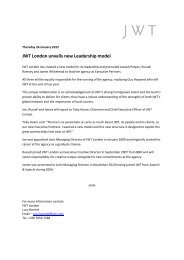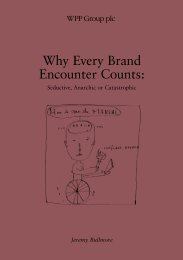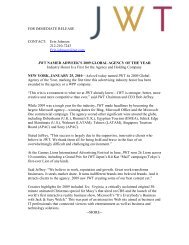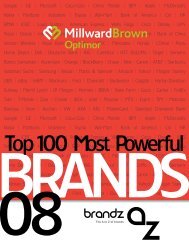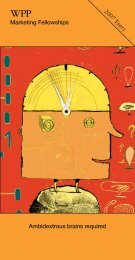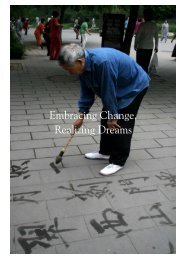Building Brands from the Inside Out - WPP.com
Building Brands from the Inside Out - WPP.com
Building Brands from the Inside Out - WPP.com
- No tags were found...
Create successful ePaper yourself
Turn your PDF publications into a flip-book with our unique Google optimized e-Paper software.
1THE FOUR CATEGORIESOF ENGAGEMENTConsider <strong>the</strong> average <strong>com</strong>pany. Assume that <strong>the</strong> ideal employee is someone whoboth understands what <strong>the</strong> <strong>com</strong>pany is trying to do and is emotionally <strong>com</strong>mittedto helping it succeed. What proportion of employees do you think fall into this category?80%? 60%? 40%?Well, keep lowering your estimate. In <strong>the</strong> average <strong>com</strong>pany, this type of employee—called a brand champion—is outnumbered more than two to one by o<strong>the</strong>r types ofemployees. Some employees—<strong>the</strong> loose cannons—may care about what <strong>the</strong> <strong>com</strong>panyis trying to do but don’t know what to do about it. O<strong>the</strong>rs—<strong>the</strong> bystanders—knowwhat <strong>the</strong> <strong>com</strong>pany is trying to do but don’t care. And still o<strong>the</strong>rs—<strong>the</strong> weak links—nei<strong>the</strong>r know nor care. To make matters worse, in <strong>the</strong> average <strong>com</strong>pany <strong>the</strong>se weaklinks make up <strong>the</strong> biggest group—almost 40%¹ (see <strong>the</strong> Enterprise IG Buy-in Matrixon page 2).That’s <strong>the</strong> bad news. The good news is that this means most <strong>com</strong>panies havetremendous upside potential. What would happen if <strong>the</strong>y could find a way to turn<strong>the</strong> loose cannons, which number about 30%, into brand champions? How would<strong>the</strong> atmosphere and performance change if <strong>com</strong>panies found a way to turn <strong>the</strong>weak links into <strong>com</strong>mitted, knowledgeable employees?IN THE AVERAGE COMPANY, BRANDCHAMPIONS ARE OUTNUMBERED MORETHAN TWO TO ONE BY OTHER TYPESOF EMPLOYEES.Internal <strong>com</strong>munications, internal marketing, internal branding—call it what youwill—<strong>the</strong> idea that it’s important to get employee buy-in to <strong>com</strong>pany goals andstrategies has been around for decades. Vast amounts of time, money and efforthave been expended trying to motivate employees, to create cultures and <strong>com</strong>paniesthat really zing with energy and enthusiasm. Yet, over this time, things haveactually gotten worse. According to one survey, only 19% of employees think <strong>the</strong>iremployers involve <strong>the</strong>m in open, effective <strong>com</strong>munication.²ENTERPRISE IG BUY-IN MATRIXIllustration: Christoph NiemannHowever, it is possible to get it right. Look at any outstanding corporate successstory over <strong>the</strong> past few decades, and somewhere along <strong>the</strong> line you’ll find that itspeople policies—its ability to engage its employees and earn <strong>the</strong>ir <strong>com</strong>mitment—play a crucial role in its success.³ Compare Southwest Airlines and its counterpartsin <strong>the</strong> U.S. airline industry, for example. Or Tesco and standard retail practices in<strong>the</strong> U.K. Or Toyota and <strong>the</strong> fallen giants of <strong>the</strong> U.S. motor industry—General Motorsand Ford—both now boasting junk bond status for <strong>the</strong>ir debts.Whe<strong>the</strong>r it’s cause or effect is a moot point. Almost certainly it’s a <strong>com</strong>bination of<strong>the</strong> two. The fact is, organizations that create and nurture brand champion employees



